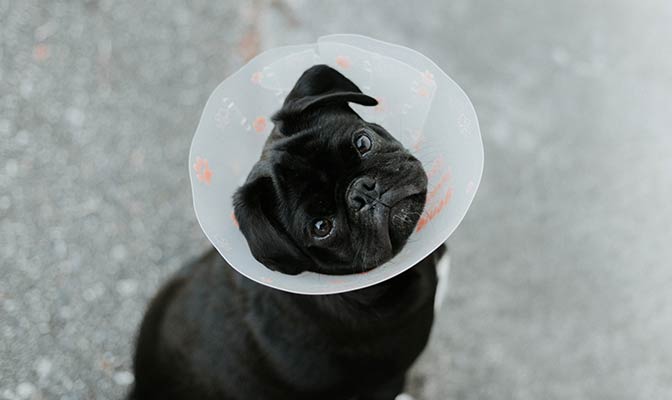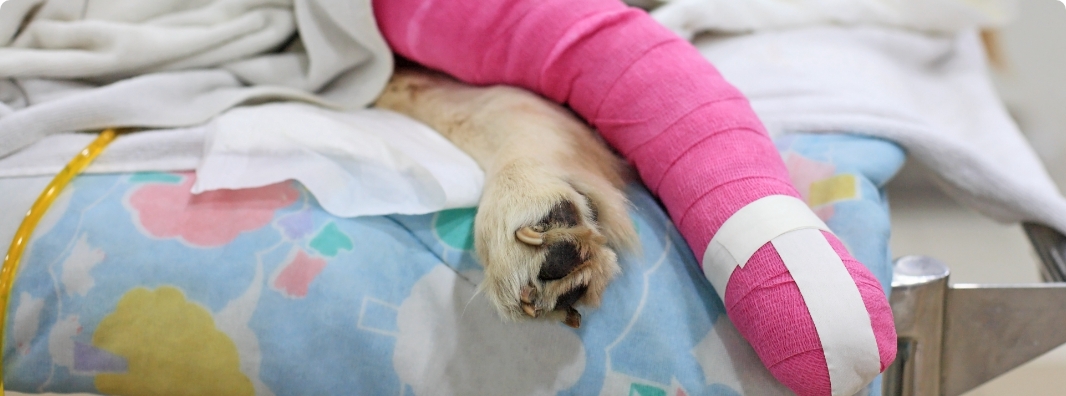Home | Medical Info | Hip Dysplasia in Dogs
Hip Dysplasia in Dogs
Keywords:
Hip dysplasia is a genetic condition that affects the hip joint, leading to instability, pain, and mobility issues. While it is most common in large-breed dogs, smaller dogs can also be affected. Early detection and treatment can significantly improve your pet’s quality of life.
At Canton Animal Hospital, we specialize in diagnosing and treating hip dysplasia, providing personalized care to help dogs live pain-free.
What is Hip Dysplasia in Dogs?
Hip dysplasia is a common orthopedic condition affecting dog hip joints, leading to pain and mobility issues. The hip joint, a ball-and-socket structure, requires synchronized growth of the femoral head (thighbone) and acetabulum (hip socket). When growth is uneven, the joint becomes loose (laxity), resulting in degenerative joint disease (DJD) or osteoarthritis (OA) over time.
Featured Resources

We Welcome New Patients!
We're always happy to give your furry friend care at our hospital. Get in touch today!
Contact Us
Key Characteristics of Canine Hip Dysplasia:
Abnormal development of the hip joint.
Joint laxity, instability, and misalignment.
Malformation of the femoral head and acetabulum.
Progression into osteoarthritis if left untreated.
Prevalence of Hip Dysplasia in Dogs
Hip dysplasia is one of the most common orthopedic disorders in dogs, particularly in large and giant breeds. It is the leading cause of canine osteoarthritis. Although rare in small dogs, hip dysplasia can occur in any breed. Large dogs (over 11-12 kg) experience more severe bone changes, while smaller breeds may have milder symptoms.
Causes of Hip Dysplasia in Dogs
Hip dysplasia is primarily genetic, but several environmental factors contribute to its severity:
Overfeeding & Rapid Growth: Uncontrolled puppy growth increases the risk.
Exercise & Activity Levels: Excessive or insufficient exercise can negatively impact hip development.
Obesity: Overweight dogs experience increased joint stress, worsening hip dysplasia.
Genetics & Breeding: Dogs with a genetic predisposition are more susceptible to hip dysplasia.
Studies indicate that controlled growth rates and maintaining a healthy weight significantly reduce the risk of hip dysplasia in large-breed puppies.
How Hip Dysplasia Develops (Pathogenesis)
Hip dysplasia results from a combination of genetic and environmental factors that lead to improper joint development. The disease progresses as follows:
Normal hip joints at birth.
Weak muscle and ligament development causes joint instability.
The femoral head and acetabulum separate, leading to joint misalignment.
Over time, arthritis and bone deterioration develop, resulting in pain and stiffness.
Early intervention through proper nutrition, exercise regulation, and selective breeding can significantly reduce the likelihood of hip dysplasia.
Dog Breeds Most at Risk for Hip Dysplasia
Hip dysplasia is most frequently diagnosed in large and giant dog breeds, including:
German Shepherds
Labrador Retrievers
Golden Retrievers
Saint Bernards
Old English Sheepdogs
Bulldogs
Large mixed-breed dogs are also prone to hip dysplasia. Feeding a large-breed growth diet in the first year can support healthy joint development.
Symptoms of Hip Dysplasia in Dogs
Signs of hip dysplasia vary based on age and severity. Common symptoms include:
Weakness and hind-leg pain.
Difficulty rising, running, or climbing stairs.
Limping, stiffness, or a wobbly gait.
Bunny-hopping movement due to joint instability.
Decreased activity levels and reluctance to play.
While some dogs show symptoms as early as a few months old, others may not display noticeable discomfort until 1-2 years of age or later. Progressive joint degeneration eventually leads to chronic pain and reduced mobility.
Diagnosing Hip Dysplasia in Dogs
The most reliable diagnosis method for hip dysplasia is X-ray imaging (radiographs) under general anesthesia. Additional diagnostic tools include:
Physical Examination: Checking for joint laxity (Ortolani Sign).
Gait Analysis: Observing limping, stiffness, and restricted movement.
Veterinary Consultation: Evaluating symptoms and breed risk factors.
Early diagnosis allows for better treatment outcomes and improved long-term joint health.
Treatment Options for Hip Dysplasia
The best hip dysplasia treatment depends on severity and pain level. Treatment options include:
Non-Surgical Treatments
Non-Steroidal Anti-Inflammatory Drugs (NSAIDs): Pain management and inflammation reduction.
Joint Supplements: Glucosamine, chondroitin sulfate, and omega-3 fatty acids.
Weight Management: Prevents excess joint stress and deterioration.
Moderate Exercise: Swimming and controlled walks strengthen muscles without overstraining joints.
Physical Therapy: Improves mobility and helps maintain joint function.
Surgical Treatments for Severe Hip Dysplasia
If medical treatment is ineffective, surgical intervention may be necessary:
Total Hip Replacement (THR): Replaces the affected hip joint with an artificial one, offering the best long-term solution.
Femoral Head Ostectomy (FHO): Removes the femoral head to alleviate pain; suitable for smaller or less active dogs.
Triple Pelvic Osteotomy (TPO): Corrects hip alignment in younger dogs with minimal arthritis.
Juvenile Pubic Symphysiodesis (JPS): Preventative surgery for young puppies at risk of developing hip dysplasia.
Help Your Dog Live a Pain-Free Life
If your dog is showing signs of hip dysplasia, early intervention is key to managing pain and preserving mobility. Contact Canton Animal Hospital today for an expert evaluation.
Total Hip Replacement in Dogs
What is Total Hip Replacement (THR)?
Total hip replacement is a surgical procedure where the diseased hip joint is replaced with prosthetic components to restore normal function. The procedure involves:
Removing and replacing both the femoral head and acetabulum with artificial prostheses.
Using either cemented or cementless implants to secure the prosthetic joint.
Ensuring long-term mobility and pain relief.
Candidate Criteria for Total Hip Replacement
Dogs must be in good overall health with no other bone or nerve diseases.
Must have completed skeletal growth, typically at 9-12 months of age.
A board-certified veterinary surgeon will assess X-rays and hip function to determine eligibility.
Post-Surgery Recovery and Care
Hospitalization for 3-5 days post-surgery to monitor healing.
Strict activity restriction and pain management for proper recovery.
Physical rehabilitation with a canine rehabilitation specialist is recommended.
Most dogs regain full activity within 3 months.
Does My Dog Need Both Hips Replaced?
80% of dogs with hip osteoarthritis only require one hip replacement for improved mobility.
Your veterinarian will assess whether the second hip needs surgery based on function and pain levels.
Femoral Head Ostectomy (FHO) in Dogs & Cats
What is FHO Surgery?
Femoral Head Ostectomy (FHO) is a surgical procedure designed to restore pain-free mobility in pets suffering from hip joint disease or injury. The procedure involves removing the head and neck of the femur (the thighbone), eliminating painful bone-on-bone contact and allowing the body to form a functional "false joint."
How Does FHO Surgery Change the Hip?
A normal hip is a ball-and-socket joint, where the femoral head (ball) fits into the acetabulum (socket) of the pelvis. When the joint is damaged or diseased, mobility becomes restricted, leading to chronic pain and inflammation. By removing the femoral head, FHO eliminates joint contact, and over time, scar tissue forms a cushion, allowing for improved mobility and reduced discomfort.
Is My Pet a Good Candidate for FHO?
FHO is generally recommended for small dogs (under 50 pounds) and cats who:
Are at a healthy weight (excess weight can hinder post-surgical success).
Have active lifestyles, as muscle mass helps stabilize the joint.
Suffer from hip fractures, luxation, severe arthritis, or Legg-Calvé-Perthes disease.
Larger dogs may also be candidates, but total hip replacement (THR) is often a more effective option.
Common Reasons for FHO Surgery
Hip Fractures: When fractures cannot be surgically repaired, FHO may be the best option.
Hip Luxation/Dislocation: Severe trauma or hip dysplasia can lead to persistent dislocation.
Severe Hip Arthritis: Advanced arthritis can cause bone-on-bone contact, leading to chronic pain.
Legg-Calvé-Perthes Disease: This condition, common in toy and small breeds, causes bone degeneration in the femoral head.
What to Expect on the Day of Surgery
Your pet will undergo general anesthesia for the procedure.
The surgery typically lasts 1 to 2 hours.
Most pets stay in the hospital for a few hours to a few days, depending on recovery progress.
Post-Operative Care & Recovery
Recovery after FHO occurs in two primary phases:
Initial Healing (First Few Days Post-Surgery)
Focus on pain management and wound care.
Administer all prescribed medications as directed.
Apply moist heat therapy to reduce stiffness.
Limit activity to short, supervised leash walks.
Rehabilitation & Strength Building (Weeks 2-6 Post-Surgery)
Gradual increase in activity is encouraged.
Passive range-of-motion exercises can aid recovery.
Walking on stairs, water therapy, and slow leash walks help rebuild muscle mass.
Avoid rough play and sudden movements for at least 30 days.
Most pets fully recover within 6-8 weeks, returning to an active lifestyle.
Prognosis After FHO Surgery
The majority of pets regain near-normal function after FHO. While the operated leg may have slightly reduced range of motion, this does not significantly affect quality of life. For best results, physical therapy and controlled exercise are crucial post-surgery.
Pubic Symphysiodesis in Puppies with Hip Dysplasia
What is Pubic Symphysiodesis (PS)?
Pubic Symphysiodesis (PS) is a minimally invasive surgical procedure designed to improve hip joint stability in puppies diagnosed with hip dysplasia at an early age. The procedure induces premature closure of the pubic symphysis, leading to beneficial acetabular rotation and improved joint conformation as the puppy grows.
Benefits of Pubic Symphysiodesis
Encourages proper hip joint development by modifying pelvic growth.
Minimally invasive with a shorter recovery time compared to pelvic osteotomy.
Best results when performed between 12 to 16 weeks of age.
Reduces severity of hip dysplasia, improving long-term joint function.
How Does Pubic Symphysiodesis Work?
The procedure involves inducing closure of the pubic symphysis using either electrocautery or stapling techniques. This results in:
40-46% improvement in acetabular coverage.
Minimal reduction (24%) of the pelvic inlet area, which is clinically insignificant.
Pelvic rotation and conformation similar to that achieved with a bilateral TPO.
Surgical Technique for Pubic Symphysiodesis
General anesthesia is administered.
The puppy is positioned in dorsal recumbency.
A 2-3 cm incision is made to access the cranial pelvic symphysis.
The rectus abdominis muscle and gracilis aponeurosis are minimally reflected to expose the pubic symphysis.
Electrocautery or surgical stapling is applied to induce premature closure of the symphysis.
The skin and fascial layers are closed using standard surgical techniques.
Post-Operative Care & Recovery
Most puppies can go home the same day after surgery.
Minimal analgesia required, as the procedure is less invasive.
Moderate activity recommended for 2-3 months while bony structures remodel.
Follow-up examinations to assess pelvic growth and hip development.
Schedule a Consultation Today!
If your puppy has been diagnosed with hip dysplasia, early intervention can make a significant difference in long-term joint health.
Featured Resources

We Welcome New Patients!
We're always happy to give your furry friend care at our hospital. Get in touch today!
Contact UsTips and Advice From Our Team
Looking for advice about caring for your pet? Our blog features helpful tips and educational material from our team to support your needs.




